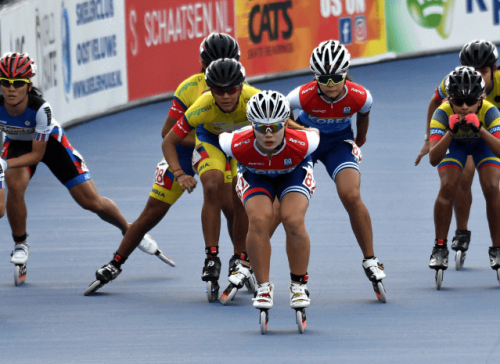Speed Skating: Everything You Need to Know

Speed skating is a discipline where endurance plays a huge role. Competitions are held on different surfaces and races range from short distances (200 meters) to long distances (42 meters). Find out more about this sport in the following article.
You might like: The Benefits of Skateboarding
Characteristics of rollerblading
This type of skating occurs on a hard floor area and the skates have wheels. People also use roller skates or rollerblades to skate on the streets. Speed rollerblading is one of the most famous versions of this sport. Competitions take place on an oval-shaped track with inline skates.
The idea of this sport is that you finish all of the laps around the track before the other competitors.
This sport is very physically and mentally demanding and is an aerobic exercise that requires a lot of preparation and training. It’s more than just speed: this sport combines strength, ability, and endurance.
In addition, it also involves strategy, with the end goal being exertion and endurance in order to reach the finish line before the others.
The speed skating track is an oval shape, covered, and has a wooden floor. The track must have two equally straight areas and two equal curves. In addition, the track must be between 125 and 400 meters long.
There are different types of speed skating competitions:
- Lane races: 80 to 100 meters
- Individual time trials: 200 to 300 meters
- A short distance in groups: 500 to 1,000 meters
- Medium distance: 2,000 to 5,000 meters
- Distance: 5,000 to 20,000 meters

Image: Instagram World Skate Organization.
Characteristics of speed skating on ice
Unlike inline speed skating, speed skating on ice has been an Olympic sport since 1924. The track is quite similar to inline speed skating but covered with a layer of artificial ice.
Another difference is the type of skates that are used. In this case, skaters use skates that allow them to slide on ice, just as those that are used in figure skating, for example.
Speed ice skating competitions are held on a 400-meter long track with two straight lines and two curves. Participants form teams of two and take part in time trials. In other words, a timer reads how long each participant takes to complete the race separately.
When both athletes finish their time trials, the fastest time appears on the clock.
One of the unusual things about speed ice skating is that every time the participants go around a curve, they must switch lanes. If they were on the inside, they’ll switch to the outside, and vice versa. It’s worth mentioning that the inside lane is shorter than the second lane, and that’s why this rule exists.
In the Winter Olympic Games, there are 12 competitions for speed skating: six men’s competitions and six women’s. These are the 500, 1000, 1500, 3000, 5000 meters, and team pursuit.
In the first competition on the list, athletes must participate in two races. On the other hand, for the last competition on the list, which was recently incorporated (in 2006), there are teams of three skaters that take turns. This is similar to what happens in track cycling.
You might like: The Best Sports to Practice in Good Weather
Characteristics of short track speed skating
The third discipline in the world of speed skating is also a Winter Olympic sport. This sport takes place on an ice track that’s shorter than the one we previously mentioned. Another difference is that the athletes directly race against each other, and it’s not against the clock.
The track is one hundred and eleven meters, oval in shape, without lane divisions. Lane divisions can cause falls and accidents during competitions, which can often lead participants to drop out of the race or even cause disqualifications. Without a doubt, short track speed skating is spectacular and definitely worth watching.

Short track speed skating first emerged in the 1960s, when people wanted a sport to practice on an ice hockey rink. In 1967, it was recognized by the International Skating Union. Likewise, in 1981, the first world championship took place.
At the 1988 Calgary Olympic Games, this was practiced as an exhibition sport. Additionally, at the following Winter Olympics, it was finally recognized as an Olympic sport.
There’s no question that speed skating is an incredible and very entertaining sport to watch, whether live or on television. What do you think of this sport? Are you interested in taking it up?
Speed skating is a discipline where endurance plays a huge role. Competitions are held on different surfaces and races range from short distances (200 meters) to long distances (42 meters). Find out more about this sport in the following article.
You might like: The Benefits of Skateboarding
Characteristics of rollerblading
This type of skating occurs on a hard floor area and the skates have wheels. People also use roller skates or rollerblades to skate on the streets. Speed rollerblading is one of the most famous versions of this sport. Competitions take place on an oval-shaped track with inline skates.
The idea of this sport is that you finish all of the laps around the track before the other competitors.
This sport is very physically and mentally demanding and is an aerobic exercise that requires a lot of preparation and training. It’s more than just speed: this sport combines strength, ability, and endurance.
In addition, it also involves strategy, with the end goal being exertion and endurance in order to reach the finish line before the others.
The speed skating track is an oval shape, covered, and has a wooden floor. The track must have two equally straight areas and two equal curves. In addition, the track must be between 125 and 400 meters long.
There are different types of speed skating competitions:
- Lane races: 80 to 100 meters
- Individual time trials: 200 to 300 meters
- A short distance in groups: 500 to 1,000 meters
- Medium distance: 2,000 to 5,000 meters
- Distance: 5,000 to 20,000 meters

Image: Instagram World Skate Organization.
Characteristics of speed skating on ice
Unlike inline speed skating, speed skating on ice has been an Olympic sport since 1924. The track is quite similar to inline speed skating but covered with a layer of artificial ice.
Another difference is the type of skates that are used. In this case, skaters use skates that allow them to slide on ice, just as those that are used in figure skating, for example.
Speed ice skating competitions are held on a 400-meter long track with two straight lines and two curves. Participants form teams of two and take part in time trials. In other words, a timer reads how long each participant takes to complete the race separately.
When both athletes finish their time trials, the fastest time appears on the clock.
One of the unusual things about speed ice skating is that every time the participants go around a curve, they must switch lanes. If they were on the inside, they’ll switch to the outside, and vice versa. It’s worth mentioning that the inside lane is shorter than the second lane, and that’s why this rule exists.
In the Winter Olympic Games, there are 12 competitions for speed skating: six men’s competitions and six women’s. These are the 500, 1000, 1500, 3000, 5000 meters, and team pursuit.
In the first competition on the list, athletes must participate in two races. On the other hand, for the last competition on the list, which was recently incorporated (in 2006), there are teams of three skaters that take turns. This is similar to what happens in track cycling.
You might like: The Best Sports to Practice in Good Weather
Characteristics of short track speed skating
The third discipline in the world of speed skating is also a Winter Olympic sport. This sport takes place on an ice track that’s shorter than the one we previously mentioned. Another difference is that the athletes directly race against each other, and it’s not against the clock.
The track is one hundred and eleven meters, oval in shape, without lane divisions. Lane divisions can cause falls and accidents during competitions, which can often lead participants to drop out of the race or even cause disqualifications. Without a doubt, short track speed skating is spectacular and definitely worth watching.

Short track speed skating first emerged in the 1960s, when people wanted a sport to practice on an ice hockey rink. In 1967, it was recognized by the International Skating Union. Likewise, in 1981, the first world championship took place.
At the 1988 Calgary Olympic Games, this was practiced as an exhibition sport. Additionally, at the following Winter Olympics, it was finally recognized as an Olympic sport.
There’s no question that speed skating is an incredible and very entertaining sport to watch, whether live or on television. What do you think of this sport? Are you interested in taking it up?
All cited sources were thoroughly reviewed by our team to ensure their quality, reliability, currency, and validity. The bibliography of this article was considered reliable and of academic or scientific accuracy.
- Egocheaga Rodríguez, J., Llavador Ros, J., Díaz-Munío Carabaza, J. J., Del Valle Soto, M., Egia Lekunberri, O., & Díaz De Bilbao, I. (2004). Economía de carrera en el patinaje de velocidad. Influencia de la posición dentro del grupo. Archivos de Medicina Del Deporte.
- E S / R A M D Artigo De Revisão, W. W. W. E. L. S. E. V. I. E. R., Piucco, T., Dos Santos, S. G., & De Lucas, R. D. (2014). Medicina del Deporte Patinaç ão de velocidade in-line: uma revisão sistemática. Revista Andaluza de Medicina Del Deporte, 7(4), 162–169. https://doi.org/10.1016/j.ramd.2014.02.002
- Kuper, G. H., & Sterken, E. (2003). Resistencia en el patinaje de velocidad El desarrollo de los récords mundiales. European Journal of Operational Research. https://doi.org/10.1016/S0377-2217(02)00685-9
This text is provided for informational purposes only and does not replace consultation with a professional. If in doubt, consult your specialist.








